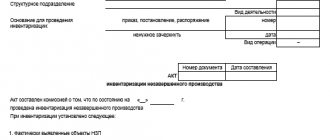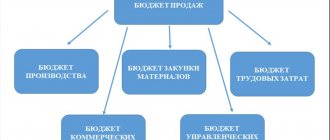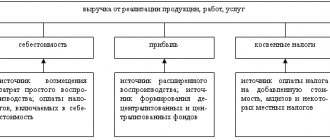Work in progress - account in accounting
According to clause 63 of Order of the Ministry of Finance of the Russian Federation dated July 29, 1998 No. 34n “On approval of the Regulations on accounting…” in accounting, work in progress in accounting is considered to be products or work that have not completed the full cycle or all stages of the technological process. In addition, unfinished products include manufactured products that have not yet passed the necessary tests and technical acceptance or are not fully equipped.
According to paragraph 64 of the same order, the value of work in progress is reflected in accounting in several ways, namely by:
- planned or actual production cost;
- direct cost items;
- cost of used raw materials, semi-finished products and materials.
These methods relate to serial or mass production, and in single production, cost estimation is carried out on the costs actually incurred to manufacture the product.
According to paragraph 1 of Art. 319 of the Tax Code of the Russian Federation, work in progress is a product that is partially ready, that is, it has not gone through all the stages of technological processing that are provided for by the applied production process. Work in progress for tax accounting purposes includes not only products, but also semi-finished products of own production, as well as materials transferred to production if they have undergone any processing.
When accounting for work in progress, account 20 “Main production” is used, the debit of which collects all costs incurred during the production process. At the end of the month, the cost of finished products is written off from the credit of account 20, and the balance that remains in debit is work in progress.
If you have access to ConsultantPlus, check whether you correctly account for work in progress in accounting. If you don't have access, get a free trial of online legal access.
How to correctly calculate the cost of production for work in progress
Accounting for work in progress (WIP) is an important aspect of the activities of any large enterprise. Correct assessment and reflection of work in progress affects not only the calculation of product costs, but also the final indicators of financial reporting.
WIP accounting
The regulations on accounting and reporting classify the following types of products as work in progress:
- products that have not passed all stages (stages) of the technological process;
- incomplete products;
- products that have not passed technical acceptance or testing;
- work not accepted by the customer.
To understand why WIP assessment affects cost calculation, you need to consider its formula:
Cost = WIP (beginning of period) + Costs - WIP (end of period)
When reflecting work in progress in accounting, the following types of estimates are used:
- according to actual costs,
- at actual or planned production cost,
- at the cost of the raw materials used.
You should know that in mass production you can use any of these options, but in single production - only an estimate based on actual costs.
Organizations that provide complex services or produce products in several stages may recognize the sale as one of 2 methods:
- in general as work (service);
- at separate stages.
If the accounting policy of such an organization assumes the second option, then account 46 “Completed stages for work in progress” is applied and the following entries are made:
- Dt 46 Kt 90 - the cost of completed stages is reflected in the accounting;
- Dt 62 Kt 46 - the customer paid for the work (services).
The balances of work in progress at the end of the period in quantitative terms can be established using an inventory or a documentary method. Then the accounting department calculates their value.
As a result, WIP is the balance of accounts 20 “Main production”, 44 “Sales expenses”, as well as 23 “Auxiliary production” and 29 “Service production and facilities”.
If you own a piece of land, you must pay land tax.
Read this article on how to calculate net working capital.
Tax accounting of work in progress
Article 318 of the Tax Code of the Russian Federation states that the organization independently establishes the procedure for distributing direct costs for finished products (GP) and WIP. It is important to take into account that costs must correspond to the products produced. The taxpayer must reflect this procedure for assessing work in progress in the accounting policy and apply it during two tax periods.
In general, the calculation of work in progress occurs in 4 stages :
- calculation of the total amount of expenses;
- calculation of work in progress balances at the end of the period;
- calculation of GP balances at the end of the period;
- calculation of the cost of the remaining products shipped but not paid for.
WIP Inventory
Inventory of work in progress is carried out in accordance with the order of the Ministry of Finance of the Russian Federation dated June 13, 1995 No. 49, which contains methodological recommendations. According to this order, a mandatory inventory may be carried out (when changing the MOL, reorganization, theft or damage, reporting), and the accounting policy may also establish other cases for conducting an inventory.
First of all, the manager must draw up an order that includes the following points:
- description of the property being inspected,
- reasons for carrying out, start and end date,
- members of the commission,
- deadlines for submitting documents to the accounting department.
WIP verification is carried out by weighing, measurements, and calculations. At the same time, the inventory does not include materials and semi-finished products that have not undergone any processing, as well as defects.
The inventory results are reflected in the inventories for each workshop, site, and division. Based on the inventory results, the following entries are made:
| No. | operations | Corresponding accounts | |
| Debit | Credit | ||
| 1 | surpluses are capitalized | 20 | 91.1 |
| 2 | shortage reflected | 94 | 20 |
| 3 | shortages within the norms are written off as production costs | 20 | 94 |
| 4 | shortage in excess of norms is written off to the guilty person | 73.2 | 94 |
| 5 | shortfalls in excess of norms are written off as other expenses | 91.2 | 94 |
Learn all about the methods of calculating depreciation.
What capital investments are is described here.
You can read about the assignment of the right of claim at https://helpacc.ru/buhgalteria/raschety/ustupka-prava-trebovaniya.html.
Work in progress in reporting
In the balance sheet, work in progress is reflected in the second section “Current assets” on line 1210 “Inventories”. Organizations with a long production cycle can reflect work in progress as part of non-current assets.
If the balance of work in progress is significant, they are reflected as a separate line in the balance sheet, and more complete information about work in progress is also disclosed in the annex to the balance sheet and the income statement (for example, the work in progress is detailed by workshop, production, stage).
Source: https://helpacc.ru/buhgalteria/aktivy/uchet-nzp.html
Main aspects of assessing work in progress and calculation formula
The method that was chosen in the organization to determine the cost of products must be enshrined in the accounting policy. The financial result of the reporting period, as well as the amount of corporate income tax, largely depends on it.
Let's take a closer look at the methods for assessing work in progress that are used in accounting:
1. Valuation at planned (standard) cost
This method is based on the Standard Guidelines for the Application of the Standard Accounting Method dated January 24, 1983 No. 12, which reflects specific recommendations for application. It can be used in the production of complex products related to clothing, furniture, metalworking, engineering and similar industries with a long production cycle.
The accounting method at planned (standard) cost involves accurate accounting of available quantitative data on the balances of work in progress (hereinafter referred to as WP). It is based on the use of standards to account for all costs incurred, as well as deviations from standards in order to identify the causes and location of their occurrence.
Standard cost is a kind of accounting price, which is calculated for each group or type based on product cost calculations. In this case, the cost of work in progress is calculated as follows:
Cost of IR = Number of IR × Unit cost of IR.
2. Valuation at actual cost
With this method, a complete calculation of the cost of manufactured products is carried out, according to which the assessment of work in progress in accounting is done based on direct and indirect costs. This method should be applied to all types of products, and therefore it should be used if the enterprise has a fairly small range of products or works.
The actual cost of work in progress, as well as finished products, will be calculated using the formula:
Actual cost = direct costs + production overhead + general operating expenses.
3. Valuation based on the cost of raw materials
This method is also called the raw material method, and is most often used when production is considered material-intensive. At the same time, direct costs of raw materials and materials have the largest share in costs.
Read about accounting methods in the article “Basic methods of accounting for production costs.”
Ways to evaluate work in progress
WIP assessment can proceed as follows:
- at the cost of consumables, raw materials and semi-finished products;
- by items of direct costs;
- according to the actual or standard cost of production.
According to Clause 7 of PBU 1/2008, the method used to evaluate work in progress must be fixed in the accounting policy of the enterprise for the convenience of accounting.
WIP assessment
Estimation based on the cost of consumables
If a production organization evaluates work in progress at the cost of consumables (raw materials, semi-finished products, purchased finished products and homogeneous mass), then the cost of the balances is determined by the following formula:
SRM × FO WIP = CO WIP, where
CPM - the cost of consumables, raw materials, semi-finished products, purchased finished products and homogeneous mass transferred to production areas for further processing
FO WIP – actual balances of work in progress, expressed in quantitative terms (g, kg, V, m). The amount of WIP balances can be determined at the end of the month based on the results of the inventory or on the basis of the primary data of the reporting documentation (Form No. MX-15).
CO WIP – the cost of work in progress balances.
An example of determining WIP balances:
A certain company produces A4 paper. Cost accounting is carried out using Account 40, since the accounting policy of this enterprise provides for the assessment of work in progress at the cost of consumables.
In May, 30 m3 of wood was supplied for paper production, the cost of which was 120,000 rubles excluding VAT. The cost of 1 m/cube of wood is 4,000 ₽. As a result of the inventory as of May 31, wood residues in the amount of 4 m/cub. were identified at the production sites.
Direct production costs amounted to 230,711 ₽:
- 120,000 ₽ — cost of raw materials;
- 86,000 ₽ — wages of production workshop employees;
- 24,711 ₽ - the amount of contributions to the funds of compulsory pension, medical social and other types of insurance.
147,000 ₽ - the amount of indirect expenses of the enterprise for the month.
The total amount of the company's expenses for the month of May was: 230,711 ₽ + 147,000 ₽ = 377,711 ₽. Following from these calculations, the following entries must be made in the accounting records of the enterprise:
Debit 20 Credit 10 (25, 26, 68, 69, 70…)
— 377,711 ₽ costs for the production of office paper are taken into account
Debit 40 Credit 20
— 361,711 ₽ (120,000 ₽ ÷ 30 m/cube ×26 m/cube +86,000 ₽ +24,711 ₽ + 147,000 ₽ = 361,711 ₽) — actual cost of finished products
Thus, the cost of WIP balances will be calculated by the difference between direct costs and actual cost: 377,711 ₽ - 361,711 ₽ = 16,000 ₽
This difference is the balance on Account 20 at the end of May.
Estimation based on direct costs
When applying the method of assessing work in progress using direct cost items, direct costs are distributed between the balances of account 20 and finished products.
Assessment based on actual and standard costs
When applying the method of assessing work in progress at actual or standard cost, the volume of work in progress is assessed based on conditional indicators that the enterprise sets independently at the stage of financial planning. As an example, you can use in the quantitative value of finished products a value equivalent to the number of finished products for the previous reporting period.
In order to calculate the equivalent number of finished products, it is necessary to know the value of the finished product coefficient at each stage of the production cycle, as well as the coefficient of non-processed raw materials (or partially processed) in physical units of measurement. To calculate the amount of remaining raw materials and partially finished products, use form No. МХ-19 approved by Rostatat Resolution No. 66 dated August 9, 1999, or form M-17 approved by Roskomstat of Russia Resolution No. 71a dated October 30, 1997.
The readiness coefficient of products that have passed the next stages of the production process is calculated on an accrual basis, taking into account the coefficient for previous stages of production. The value of these coefficients is established by the technological service bodies of the enterprise.
To determine the volume of WIP equivalent to the amount of finished products at the end of the month, it is necessary to calculate the number of finished products after each stage of production. The calculation can be made using the following formulas:
- OS 1× KeGP 1 = EC GP 1, where
OS 1 - remains of raw materials not processed, or partially processed at the first stage of the production process in natural measurements
KeGP 1 - product readiness factor at the first stage of the production cycle
EC GP 1 - equivalent amount of finished products at the first stage of the production cycle
- OS 2× KeGP 2 =EK GP 2, where
OS 2 - remnants of raw materials not processed, or partially processed at the second stage of the production process in natural measurements
KeGP 2 - product readiness factor at the second stage of the production cycle
EC GP 2 - equivalent amount of finished products at the second stage of the production cycle
- EC GP = EC GP 1 + EC GP 2 +…, where
EC GP 1 - equivalent amount of finished products at the first stage of the production cycle
EC GP 2 - equivalent amount of finished products at the second stage of the production cycle
EC GP - equivalent quantity of finished products at the end of the month
An example of determining WIP balances based on actual costs
The company is engaged in sewing mink coats. At the beginning of the month of June, no production balances were recorded. The accounting policy of the enterprise provides a method for assessing production by calculating the actual costs of providing it. All general business expenses are written off to Account 20 at the end of the month.
The chief technologist of the enterprise approved the size of the product (fur coat) readiness factor after each stage of the production cycle:
- processing and processing of raw materials (skins) – 30%;
- local cutting and sewing – 70%;
- laser processing and production of the finished product – 100%.
In June, 650 skins were sent to production sites with a total cost of 650,000 rubles (excluding VAT). According to the standard technological indicators, it is planned to sew 65 fur coats from this amount of raw materials, at the rate of 10 pieces of skins per 1 unit of product. As of June 30, 49 units of finished products were transferred to the warehouse.
Direct production costs were:
- 650,000 ₽ — cost of raw materials;
- 128,000 ₽ — wages of production employees, taking into account insurance contributions (pension, medical, social and other types of insurance);
- 37,000 ₽ - the amount of production costs;
- 44,000 ₽ - the amount of general business expenses.
In June, the accounting department made the following entries:
- Debit 20 Credit 10: 650,000 ₽ - materials for production support were written off.
- Debit 20 Credit 70 (69): 128,000 ₽ wages of production cycle employees are written off, taking into account insurance contributions (pension, medical, social and other types of insurance).
- Debit 20 Credit 25: 37,000 ₽ general production expenses are written off.
- Debit 20 Credit 26: 44,000 ₽ general business expenses are written off.
As of June 30, the following remains of partially processed raw materials were identified:
- at the stage of processing and dressing of skins - 30 pieces;
- at the stage of pattern cutting and sewing - 80 pieces.
Taking into account these indicators, the accountant calculated the equivalent amount of finished products in the balances at each stage of production. The volume of work in progress was:
- at the processing and dressing stage: 30 pcs ÷ 10 pcs/unit × 20% = 0.6 units;
- at the cutting and sewing stage: 80 pcs ÷ 10 pcs/unit × 80% = 6.4 units.
The volume of work in progress at the end of June is: 0.6 units + 6.4 units = 7 units.
Total production for June: 49 units + 7 units = 56 units including work in progress.
The total production costs are: 650,000 ₽ + 128,000 ₽ + 37,000 ₽ + 44,000 ₽ = 859,000 ₽
The actual cost of finished products that were transferred to the warehouse is reflected by the posting: Debit 43 Credit 20,859,000 ₽ ÷ 56 units × 49 units = 751,625 ₽ the actual cost of finished products for June is written off
The value of WIP balances at the end of the month (debit balance on Account 20 as of June 30 is: 859,000 ₽ - 751,625 ₽ = 107,375 ₽
Cost increase factor
It is necessary to talk separately about the cost increase coefficient, which is a characteristic of the increase in costs per unit of production as the technological cycle progresses. It is used when it is necessary to determine how certain costs that have dynamics increase, for example, wages, electricity, depreciation of fixed assets.
The rise factor (K) is calculated using the following formula:
K = Cost of a unit of production in NP / Total amount of production costs.
This is the most general formula that reflects the basic essence of the coefficient.
IMPORTANT! In practice, more complex calculations based on the above formula can be used for different types of production. This depends on the purpose of the calculation and the characteristics of the production process itself.
Work in progress account: what is the method for generating entries and writing off expenses for losses
At the end of the month, in order to identify the balance on account 20, you should take into account the costs that were incurred during the production process. It is necessary to understand that it accumulates all costs, both direct (attributable directly to the technological process) and indirect, also associated with production (general production and general economic).
The amount received in the debit of account 20 is the cost of manufactured products. It can be of 2 types:
- full, including direct, general production and general economic costs;
- reduced, including direct and general production costs.
IMPORTANT! The method for determining the cost of production must be enshrined in the accounting policy of the enterprise.
Then the generated cost of finished products is transferred to account 40 “Product Output”, account 43 “Finished Products” or account 90 “Sales”. Account balance 20 is work in progress.
Remains of work in progress can be used next month or written off to account 91.2 “Other income and expenses.” An example of such a situation is management’s decision that unfinished material assets in the future will not be used in the manufacture of products due to the abandonment of their production. Another situation may be the liquidation of the enterprise itself, and therefore the remaining unfinished products are written off as company expenses.
For more information about writing off work in progress, read the material “Procedure for writing off work in progress (nuances).”
Procedure for carrying out inventory of work in progress
The features of conducting an inventory of work in progress, taking into account the specifics of a particular company, must be fixed in the accounting policy of the organization for accounting purposes (clause 3 of article 6 of law 129-FZ).
At the same time, with the exception of mandatory inventories, the organization independently establishes by order of the manager:
- List of inspected property and liabilities.
- The number of inventories that will be carried out in the reporting year.
- Inventory dates.
- Composition of the inventory commission.
- and so on.
In addition to conducting an inventory before preparing annual reports, a mandatory inventory is carried out in the following cases:






